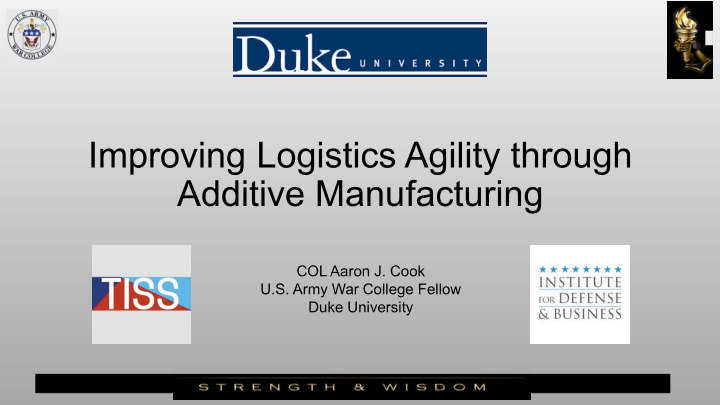



Improving Logistics Agility through Additive Manufacturing COL Aaron J. Cook U.S. Army War College Fellow Duke University
Chief of Staff of the Army General Milley: “maintain the readiness of our current force while simultaneously looking to emerging technologies for the deeper future 2025 to 2050”
Agenda • Additive Manufacturing • DoD Initiatives • Army Supply System & Policy • Benefits • Constraints • Risks • Way Ahead
Additive Manufacturing Manufacturing processes that use 3D Computer Aided Design (CAD) model data to join materials to make an object Extrusion method: Deposition & Sintering methods: • Continuous Liquid • Fused Deposition Modeling (FDM) Interface Production (CLIP) • Selective Laser Sintering (SLS) • Direct Metal Deposition (DMD)
Why Additive Manufacturing? • 24% of private manufacturing firms are using AM • Private industry is using AM to produce finished parts • 4 th Industrial Revolution: Smart Automation • Digital to physical leap • Connected digital technologies
DoD Initiatives & Reviews Air Force: Research laboratory; F-18 and F-35 Navy: Rapid Innovation Cell; USS Essex Army: Rapid Equipping Force; Army Materiel Command (AMC) Defense Logistics Agency: - Candidate part identification - Tech Data Package (TDP) refinement, storage, and security - Part certification and quality assurance standards Government Accountability Office (GAO) Report : Defense Additive Manufacturing (Jul ’14 – Oct ‘15) Government Accountability Office (GAO) Report : Defense Additive Manufacturing (Jul ’14 – Oct ‘15) U.S. Army Logistics Innovation Agency (USALIA) : Additive Manufacturing Cost- Benefit Analysis (Oct ‘15) U.S. Army Logistics Innovation Agency (USALIA) : Additive Manufacturing Cost- Benefit Analysis (Oct ‘15)
America Makes Private Industry Defense Logistics Agency Army (DLA) AMC RDECOM (DARPA) Air Force Navy Research Lab Universities
Policy • Maintain echelons of sustainment stocks • Repair parts at strategic and tactical units Double Hexagon, Self-Locking Nut
U.S. Army Supply Support Activities 279 Warehouses Over 320,000 items Over $2.7B
Benefits M1114 • Cost savings M1152 MRAP • Reduced repair part inventory • Reduction of pilferage, loss, and damage Stryker Flat Bottom • More responsive supply chain Stryker Double V-Hull • Greater flexibility • Avoidance of obsolescence
Constraints • Too slow and costly • Part certification standards • 3D Technical Data Packages (TDPs) • Raw materials: qualification, availability, consistency, and uniformity
Risks • Printed part defects • AM printer failure or loss • Raw Materials • shortage • flammability • humidity control requirements
Way Ahead • Replace traditional stockpiles of secondary item repair parts • Secure raw material intellectual property • Invest to implement technology at lowest level • Continue efforts to qualify materials and certify parts
Recommend
More recommend